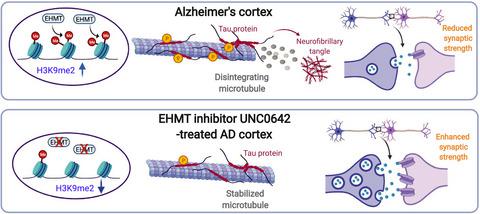当前位置:
X-MOL 学术
›
Aging Cell
›
论文详情
Our official English website, www.x-mol.net, welcomes your
feedback! (Note: you will need to create a separate account there.)
Epigenetic treatment of behavioral and physiological deficits in a tauopathy mouse model
Aging Cell ( IF 8.0 ) Pub Date : 2021-09-21 , DOI: 10.1111/acel.13456 Wei Wang 1 , Qing Cao 1 , Tao Tan 1 , Fengwei Yang 1 , Jamal B Williams 1 , Zhen Yan 1
Aging Cell ( IF 8.0 ) Pub Date : 2021-09-21 , DOI: 10.1111/acel.13456 Wei Wang 1 , Qing Cao 1 , Tao Tan 1 , Fengwei Yang 1 , Jamal B Williams 1 , Zhen Yan 1
Affiliation

|
Epigenetic abnormality is implicated in neurodegenerative diseases associated with cognitive deficits, such as Alzheimer's disease (AD). A common feature of AD is the accumulation of neurofibrillary tangles composed of hyperphosphorylated tau. Transgenic mice expressing mutant P301S human tau protein develop AD-like progressive tau pathology and cognitive impairment. Here, we show that the euchromatic histone-lysine N-methyltransferase 2 (EHMT2) is significantly elevated in the prefrontal cortex (PFC) of P301S Tau mice (5–7 months old), leading to the increased repressive histone mark, H3K9me2, which is reversed by treatment with the selective EHMT inhibitor UNC0642. Behavioral assays show that UNC0642 treatment induces the robust rescue of spatial and recognition memory deficits in P301S Tau mice. Concomitantly, the diminished PFC neuronal excitability and glutamatergic synaptic transmission in P301S Tau mice are also normalized by UNC0642 treatment. In addition, EHMT inhibition dramatically attenuates the hyperphosphorylated tau level in PFC of P301S Tau mice. Transcriptomic analysis reveals that UNC0642 treatment of P301S Tau mice has normalized a number of dysregulated genes in PFC, which are enriched in cytoskeleton and extracellular matrix organization, ion channels and transporters, receptor signaling, and stress responses. Together, these data suggest that targeting histone methylation enzymes to adjust gene expression could be used to treat cognitive and synaptic deficits in neurodegenerative diseases linked to tauopathies.
中文翻译:

tauopathy 小鼠模型中行为和生理缺陷的表观遗传治疗
表观遗传异常与与认知缺陷相关的神经退行性疾病有关,例如阿尔茨海默病 (AD)。AD 的一个共同特征是由过度磷酸化的 tau 组成的神经原纤维缠结的积累。表达突变 P301S 人 tau 蛋白的转基因小鼠发展为 AD 样进行性 tau 病理学和认知障碍。在这里,我们发现常染色组蛋白-赖氨酸 N-甲基转移酶 2 (EHMT2) 在 P301S Tau 小鼠(5-7 个月大)的前额叶皮层 (PFC) 中显着升高,导致抑制性组蛋白标记 H3K9me2 增加,这用选择性 EHMT 抑制剂 UNC0642 治疗可逆转。行为分析表明,UNC0642 治疗可有效挽救 P301S Tau 小鼠的空间和识别记忆缺陷。同时,P301S Tau 小鼠中 PFC 神经元兴奋性和谷氨酸能突触传递的降低也通过 UNC0642 治疗正常化。此外,EHMT 抑制显着降低了 P301S Tau 小鼠 PFC 中过度磷酸化的 tau 水平。转录组学分析表明,UNC0642 治疗 P301S Tau 小鼠使 PFC 中的许多失调基因正常化,这些基因富含细胞骨架和细胞外基质组织、离子通道和转运蛋白、受体信号传导和应激反应。总之,这些数据表明,靶向组蛋白甲基化酶来调节基因表达可用于治疗与 tau 病变相关的神经退行性疾病的认知和突触缺陷。EHMT 抑制显着减弱了 P301S Tau 小鼠 PFC 中过度磷酸化的 tau 水平。转录组学分析表明,UNC0642 治疗 P301S Tau 小鼠使 PFC 中的许多失调基因正常化,这些基因富含细胞骨架和细胞外基质组织、离子通道和转运蛋白、受体信号传导和应激反应。总之,这些数据表明,靶向组蛋白甲基化酶来调节基因表达可用于治疗与 tau 病变相关的神经退行性疾病的认知和突触缺陷。EHMT 抑制显着减弱了 P301S Tau 小鼠 PFC 中过度磷酸化的 tau 水平。转录组学分析表明,UNC0642 治疗 P301S Tau 小鼠使 PFC 中的许多失调基因正常化,这些基因富含细胞骨架和细胞外基质组织、离子通道和转运蛋白、受体信号传导和应激反应。总之,这些数据表明,靶向组蛋白甲基化酶来调节基因表达可用于治疗与 tau 病变相关的神经退行性疾病的认知和突触缺陷。它们富含细胞骨架和细胞外基质组织、离子通道和转运蛋白、受体信号传导和应激反应。总之,这些数据表明,靶向组蛋白甲基化酶来调节基因表达可用于治疗与 tau 病变相关的神经退行性疾病的认知和突触缺陷。它们富含细胞骨架和细胞外基质组织、离子通道和转运蛋白、受体信号传导和应激反应。总之,这些数据表明,靶向组蛋白甲基化酶来调节基因表达可用于治疗与 tau 病变相关的神经退行性疾病的认知和突触缺陷。
更新日期:2021-10-17
中文翻译:

tauopathy 小鼠模型中行为和生理缺陷的表观遗传治疗
表观遗传异常与与认知缺陷相关的神经退行性疾病有关,例如阿尔茨海默病 (AD)。AD 的一个共同特征是由过度磷酸化的 tau 组成的神经原纤维缠结的积累。表达突变 P301S 人 tau 蛋白的转基因小鼠发展为 AD 样进行性 tau 病理学和认知障碍。在这里,我们发现常染色组蛋白-赖氨酸 N-甲基转移酶 2 (EHMT2) 在 P301S Tau 小鼠(5-7 个月大)的前额叶皮层 (PFC) 中显着升高,导致抑制性组蛋白标记 H3K9me2 增加,这用选择性 EHMT 抑制剂 UNC0642 治疗可逆转。行为分析表明,UNC0642 治疗可有效挽救 P301S Tau 小鼠的空间和识别记忆缺陷。同时,P301S Tau 小鼠中 PFC 神经元兴奋性和谷氨酸能突触传递的降低也通过 UNC0642 治疗正常化。此外,EHMT 抑制显着降低了 P301S Tau 小鼠 PFC 中过度磷酸化的 tau 水平。转录组学分析表明,UNC0642 治疗 P301S Tau 小鼠使 PFC 中的许多失调基因正常化,这些基因富含细胞骨架和细胞外基质组织、离子通道和转运蛋白、受体信号传导和应激反应。总之,这些数据表明,靶向组蛋白甲基化酶来调节基因表达可用于治疗与 tau 病变相关的神经退行性疾病的认知和突触缺陷。EHMT 抑制显着减弱了 P301S Tau 小鼠 PFC 中过度磷酸化的 tau 水平。转录组学分析表明,UNC0642 治疗 P301S Tau 小鼠使 PFC 中的许多失调基因正常化,这些基因富含细胞骨架和细胞外基质组织、离子通道和转运蛋白、受体信号传导和应激反应。总之,这些数据表明,靶向组蛋白甲基化酶来调节基因表达可用于治疗与 tau 病变相关的神经退行性疾病的认知和突触缺陷。EHMT 抑制显着减弱了 P301S Tau 小鼠 PFC 中过度磷酸化的 tau 水平。转录组学分析表明,UNC0642 治疗 P301S Tau 小鼠使 PFC 中的许多失调基因正常化,这些基因富含细胞骨架和细胞外基质组织、离子通道和转运蛋白、受体信号传导和应激反应。总之,这些数据表明,靶向组蛋白甲基化酶来调节基因表达可用于治疗与 tau 病变相关的神经退行性疾病的认知和突触缺陷。它们富含细胞骨架和细胞外基质组织、离子通道和转运蛋白、受体信号传导和应激反应。总之,这些数据表明,靶向组蛋白甲基化酶来调节基因表达可用于治疗与 tau 病变相关的神经退行性疾病的认知和突触缺陷。它们富含细胞骨架和细胞外基质组织、离子通道和转运蛋白、受体信号传导和应激反应。总之,这些数据表明,靶向组蛋白甲基化酶来调节基因表达可用于治疗与 tau 病变相关的神经退行性疾病的认知和突触缺陷。










































 京公网安备 11010802027423号
京公网安备 11010802027423号